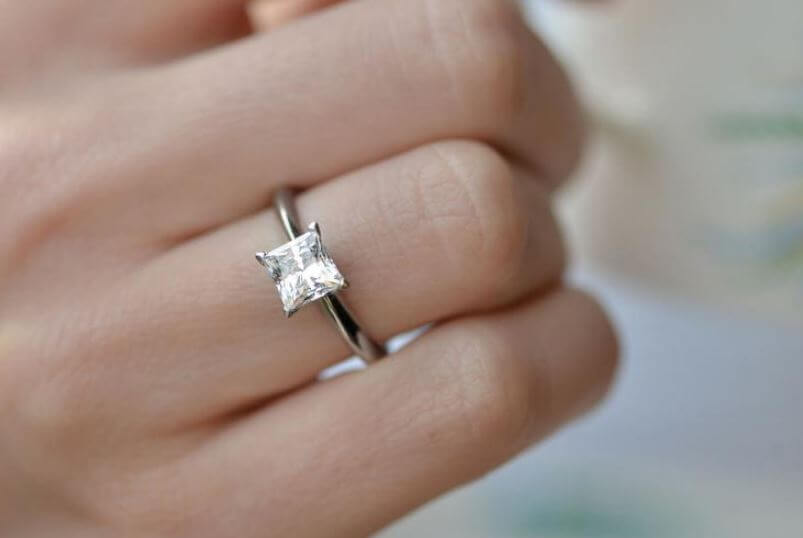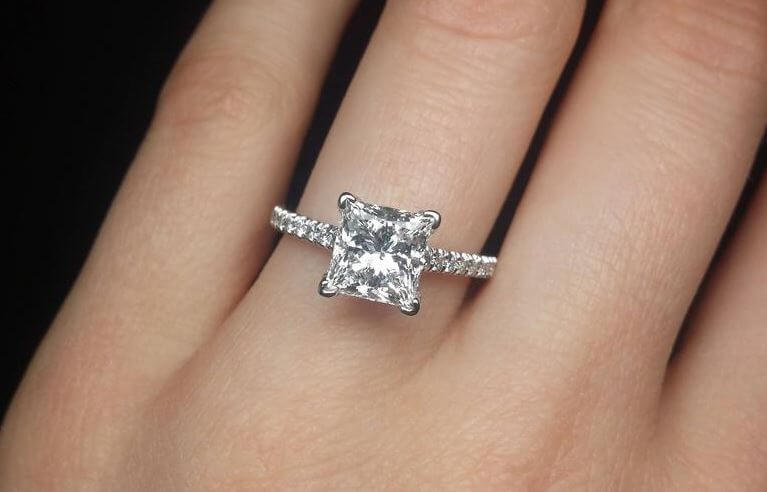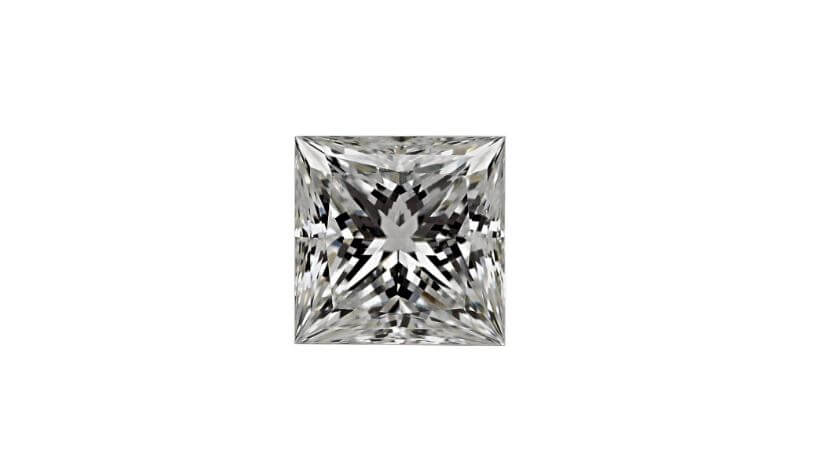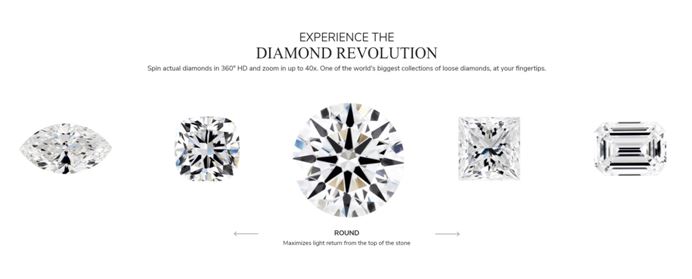The History of Princess Cut
The name“princess cut” before originally refers to an entirely different shape known as the “profile cut” which was designed and created in London in 1961 by a diamond cutter named Arpad Nagy. Moreover, more square cuts (which were precursors of princess cut) were given the same name such as the 48 facets diamond called the Quadrillion cut created by Ygal Perlman, Betzalel Ambar, and Israel Itzkowitz in 1970, and the Barion cut which is a square cut with rounded corners that boasts extremely symmetrical lines which proved quite difficult to cut, created by Basil Watermeyer of South Africa in 1971. Later on, in 1979, Ygal Perlman, Betzalel Ambar, and Israel Itzkowitzgave the same name to a different shape which was popularized in Israel, and finally creating the “SquareModified Brilliant” or what is known today as the Princess cut. Finally, after years of research, the modern Princess cut was created.
What is a Princess Cut Diamond?
The princess cut diamond is a square(which can be sometimes rectangular) stone that has 58 facets similarly arranged like a round brilliant-cut diamond. It has become popular in becoming a worthy substitute to the round brilliant due to the square shape that princess cut diamonds often have, its sharp edges, and pyramid profile. Unlike the round diamond which can only utilize as little as 50-40% of the rough stone, the princess cut is considered as a more economical choice due to the fact that less of the rough diamond is wasted when cutting this shape. While the standard for all other diamond shapes was the round brilliant cut (which was also accounted for more than 75% of diamonds sold today), the fancy cut or fancy shape diamond cuts have also gained popularity and success during the present parts of the last century. The princess cut is part of this fancy shape diamond cuts, together with many other fancy shapes such as the oval, the marquise, the pear, the heart, the emerald, the brilliant, and the radiant. Some of the fancy shapes are better suited for retaining the maximum weight of the more flat forms of diamond rough (called macles or flats), and many are also cut from the less perfectly shaped octahedral and dodecahedral crystals.
However, unlike the brilliant-cut diamond, the specific proportions that make up the “Ideal Cut’ of most of the fancy shaped diamonds have not been conclusively determined by GIA yet. GIA released its own overall cut grade system in January 2006, but only for round brilliant diamonds. GIA has the reputation of being the world’s most recognized authority on diamonds, and up to this day, GIA has not yet provided information on their princess cut reports that would enable a consumer to understand critical light performance aspects of diamonds. Fortunately, because of the American Gem Society Laboratories’ (AGSL) research, the cut quality of princess cut diamonds finally came about, and on May 2005, AGSL launched its light performance-based cut grading system. The grading system was first released for round brilliant cuts and later expanded for the greater complexity of fancy shapes. In June 2005, the princess cut was then added to the system, where it was the first among several other shapes to be included and released. A team of gemologist and top scientists in the fields of optics, physics, and mathematics took part in AGS’s initiative, where the first scientifically severe, peer-reviewed cut grading system was born, finally providing incentive to cutters to spend the extra time and sacrifice the extra rough necessary to produce top quality princess cuts, with a reliable certificate to attest to their overall cut quality.

Composition of a Diamond’s Beauty and Quality
A diamond’s optical beauty is determined by three features, namely: brilliance, dispersion, and scintillation. The brilliance of a diamond is essentially its capacity to shine and refract light. A diamond has a refractive index of 2.42, which is a very high value compared with that of other jewels (the index of a crystal is 1.55; rubies and Sapphires, 1.77). On the other hand, diamond dispersion happens when white light enters a diamond, separates the visible light spectrum into all the seven spectral colors of the rainbow, and bounces back to the viewer’s eyes in a wonderful display of colored light, also known as diamond fire. Flashes of color and flashes of light are the life of any stone; it’s what makes diamonds beautiful and valuable. This unique sparkle and brilliance are what separates diamonds from all other gemstones in the world. And lastly, scintillation is the glittering of the reflected light of a diamond caused by the movement of either the observer or the diamond itself. Scintillation depends primarily on the size of the diamond, the number of facets, the polish of the facets, and the accuracy of the angles of the respective facets.
Moreover, brilliance, dispersion, and scintillation vary greatly according to the aspects with which diamonds are measured and assessed. These aspects are well known as the 4Cs of diamonds, which means Cut, Clarity, Color, and Carat. Cut refers to both the geometric proportions and symmetry of a gemstone and the final polished form into which the rough stone is shaped. The most prominent cuts in the industry are the brilliant-cut and fancy shapes. A good cut gives a diamond its brilliance, dispersion, and scintillation, or in short, its appearance and appeal. Clarity, on the other hand, is the measure by which a diamond is graded for purity, or whiteness, taking in the presence or absence of blemishes on the diamond’s surface, or inclusions within the diamond. The professional grading scale for clarity is as follows: flawless (F); internally flawless (IF); very, very slightly included (VV); very slightly included (VS); slightly included (SI); included (I). (Image below shows GIA’s grading scale for a diamond’s Clarity)
Furthermore, color refers to the system of grading diamonds on the quality of their tint, from colorless to a pronounced yellow hue. Modern methods use letters to designate differences in colors. They are D-F, for colorless; G-J, for nearly colorless, K-M, for faintly yellow; N-R, for very light yellow; S-X, for light yellow; Y-Z, for yellow. The traditional method ascribes names to the variations in tint: pure white (extra river; river), top-white (wesselton), off-white (silver cape, tope cape, cape, dark cape), yellow, and brown.
Lastly, carat is the unit of weight (equal to 200 milligrams) by which a diamond or other gemstone is measured. The word is derived from the word “carob bean”, whose consistent weight was historically used to measure gemstones.
In addition to these properties, some diamonds exhibit a characteristic called fluorescence. On a GIA Diamond Grading Report, fluorescence refers to the strength, or intensity, of the diamond’s reaction to long-wave UV, which is an essential component of daylight. The light emitted lasts as long as the diamond is exposed to the ultraviolet source. In more than 95% of the diamonds that exhibit fluorescence, the visible color is blue. As blue is the complementary color to yellow, the most common tinted color in diamonds, blue fluorescence can make yellowish diamonds look white or colorless. In rare instances, the reaction to fluorescence is yellow, white or another color. In many instances, observers prefer the appearance of diamonds that have medium to strong fluorescence. In rare cases, some diamonds with extremely strong fluorescence may appear hazy or oily; less than 0.2% of the fluorescent diamonds submitted to GIA exhibit this effect.

What to look for in a Diamond: The Ideal Princess Cut
Among the four Cs, the beauty of a diamond depends greatly on cut than any other factor. A poorly cut diamond, no matter how great its color and clarity is, will not compare in sparkle and flicker to a better cut diamond with comparatively lower color and clarity. If you want to witness a diamond dancing and coming to life, making you dazzle and knock your socks off, the number one rule to diamond shopping is to get an excellent cut. And, out of the many styles of diamond, the princess cut is one of the most enhancing and enchanting styles for wedding or engagement rings. It is one of the two square-shaped (or can also be rectangular or tapered) diamond rings where the best thing about it is that it is a forgiving cut, so it can hide small imperfections, which makes it affordable as compared to any other cut. Apart from that, their exceptional flash qualities make them look amazing in all sizes and colors. The princess cut is like an upside-down pyramid, with much of its weight in the pavilion, so the face-up appearance of the finished diamond may appear smaller than another diamond of a different shape but of similar carat weight. The crowns of the modern princess cut are designed in two basic styles; Bezel corners with a small diamond-shaped facet from the table corner to the stone corner, and French corners where the star facets point to the stone corners and usually extend about 50% of the distance from the table corner to the stone corners. The number of facets and the faceting arrangement on the pavilion and crown can vary widely, creating a wide variety in scintillation, the combination of how much it sparkles and the pattern of the sparkle. However, whether you buy a round brilliant or princess cut ring, it is extremely important to choose it wisely. The following are what to look for in princess cut diamonds:
Shape: A square princess cut has a length-to-width ratio not exceeding 1:05:1. Princess cuts that have uneven sides or unequal proportions are less attractive.
Symmetry: The symmetry of the facets helps to create the beauty of the cut. You can look for this by drawing an imaginary line down the length of the diamond, and see if the facets on the right and left halves are the same shape and size. Also, look for all the points of the facets to meet and that there are no missing or extra facets. Then draw an imaginary horizontal line across the diamond, and see if the facets on the bottom and top halves are symmetrical. The more symmetrical the facets are, the more desirable the diamond becomes.
Scintillation: A balanced contrast of light and dark patterns in the table and facets are important. A stone that is either too light or too dark is typically not as attractive as one that has a pleasing balance.
Moreover, here are the ideal 4Cs of a princess cut diamond:
- Cut: Cut is one of the most important characteristics of a diamond, as it has the greatest influence on the beauty of a diamond. Although the cut is not graded by GIA, the ideal depth for princess cut is 65 to 75% and it should be a very good cut.
- Color: Color is considered to be the second most important characteristic. The color grade starts from D to Z; where D is the highest and Z is the lowest possible. The grade is based on a lack of color. Lesser the color, the higher the grade. D to J is nearly colorless, while M to Z has a noticeable color. However, G, H, I or J is the best color for princess cut.H Color or I Color in a princess cut diamond will give you more value for your money. Although, the higher the color, the better the diamond is. One thing to look for when evaluating the color of a princess cut diamond is to look for a diamond that doesn’t have a visible yellow tint. It is not important to spend additional money to buy a Colorless princess cut diamond i.e. ones graded as D, E, and/or F. Any of these colorless grades will not have a conspicuous difference in color with the naked eye as saying I or J colors. G and H color diamonds are also considered as relatively high-quality stones and should be a top option for people with budget constraints.
- Clarity: Clarity is the measure of imperfections which occurs in almost all diamonds. However, it does not affect the overall beauty of the diamond. The ones with the least imperfections get the highest clarity grades. It starts from I1, I2, I3 where I stand for Included, followed by SI1 and SI2 where SI stands for Slightly Included, VS1, VS2 stands for Very Slightly Included, followed by VVS1 and VVS2 for ‘Very Very Slightly Included’ and FL, IF stands for Flawless, Internally Flawless. However, for princess cut diamonds, you can go for VS1, VS2 or SI1. One thing to pay attention to when buying these sparkling diamonds is to make sure the diamond you choose doesn’t have serious inclusions in its corners. Large inclusions lead to weakened corners which then make the diamond susceptible to chipping.
- Carat: Carat is a term for the weight of the diamond, which is not related to the size of a diamond. However, we determine the size of the diamond by viewing from the top, as that is how they are represented in rings. Carat weight is considered for determining the size of the ring along with other factors like distance across the top of the diamond (in mm) and cut grade. You can choose carat as per your budget.
The table below represents a set of guidelines to use as a rule of thumb when evaluating the cut of a princess cut diamond.
| Depth % Excellent: 64-74.9 Very Good: 64-74.9 Good: 59-64/75.5-81 Fair: 56.5-84 Poor: <54 or >84 | Table % Excellent: 62-69 Very Good: 58-61/71.1-73.9 Good: 55-59/75-81 Fair: 55-81/52-85.3 Poor: <52 or >87 |
| Crown Height % Excellent: 10-16 Very Good: 9-15.5 Good: 6-17.9/8-17 Fair: 5.2-18/4.1-20 Poor: <3.2 or >21 | Girdle Excellent: Very Thin-Slightly Thick/Thin-Thick Very Good: Very Thin-Slightly Thick/Thin-Thick Good: Very Thin-Thick Fair: Very Thin-Very Thick Poor: Extremely Thin-Extremely Thick |
| Length/Width Ratio: Square Range Excellent: 1.00-1.05 Very Good: 1.00-1.05 Good: 1.00-1.05 Fair: 1.059-1.079 Poor: >1.079 | Length/Width Ratio: Square Range Excellent: 1.00-1.05 Very Good: 1.00-1.05 Good: 1.00-1.05 Fair: 1.059-1.079 Poor: >1.079 |
| Cullet Excellent: None Very Good: Slight Good: Small Fair: Average Poor: >Average | |
| Length/Width Ratio: Square Range Excellent: 1.00-1.05 Very Good: 1.00-1.05 Good: 1.00-1.05 Fair: 1.059-1.079 Poor: >1.079 | Length/Width Ratio: Rectangular Range Excellent: 1.49 -1.73 Very Good: 1.49 -1.1.73 Good: 1.49 -1.173 Fair: 1.48 -1.74/2.00 Poor: <1.48 – >2.00 |
What to consider when purchasing a Princess Cut Diamond
Below is a list of suggested carat weight, cut, color and clarity of Princess Cut Diamond for people with budget constraints.
Excellent Choice:
Weight: At least 1.0 carats
Polish and Symmetry: Very Good to Excellent
Color: G or above
Clarity: SI1 or above
Fluorescence: None
Length/width ratios:
- Square: 1-1.05
- Rectangular: 1.5-1.75
Very Good Choice:
Weight: At least 0.90 carats
Polish and Symmetry: Good to Excellent
Color: H or above
Clarity: SI2 or above
Fluorescence: None, faint or medium blue
Length/width ratios:
- Square: 0.95-1.05
- Rectangular: 1.5-1.75
Good Choice:
Weight: At least 0.80 Carats
Polish and Symmetry: Good to Very Good
Color: I or above
Clarity: SI2 or above
Fluorescence: None, faint or medium blue
Length/width ratios:
- Square: 0.95-1.05
- Rectangular: 1.5-1.75
Also, always make sure to choose a setting that protects the diamond’s corners. When a diamond is set in a mounting that has rough edges, it causes the diamond to become very thin. Not just that, a strong blow can also eventually chip the diamond off. To provide a safe mounting for your diamond, choose a V-prong setting.
Reasons to purchase a Princess Cut Diamond
When considering stone for an engagement ring, an additional stone for your existing ring, or a stone to create an entirely new piece, consider the princess cut diamond as a strong candidate. Princess cut diamonds look extremely regal when setting in engagement rings, earring settings, pendant settings, and bracelet settings. The delightful appearance of this rather new shape provides one with a modern fresh look while maintaining much of a brilliant diamond’s shine. Also, as a result of the way the diamond is cut, the stone appears quite large and again possesses the brilliance people to look for when shopping for a piece of diamond jewelry. However, there are some little unwanted points about this stone. Among all the different shapes, the princess cut is among the most prone to snag your clothes. In addition, as their sharp edges stick out they can be at risk for chipping. Now, these shouldn’t be reasons not to invest in this stone, but just make sure you know what you are getting into. People aren’t really aware that there is a need to care for the diamond jewelry they wear and princess cut diamond is one of the many diamonds that demand good care.

